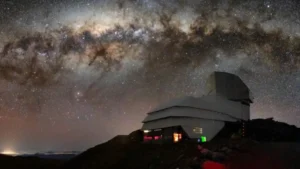In the litany of human contrivances for lodging — be it the lean-to or The Line — who would have guessed the bouncy castle could be our first extraterrestrial home?
There’s no guarantee it’ll happen, but you might not want to count it out. The European Space Agency (ESA) unveiled a concept this year for an “Inflatable Moon Base” (that’s not a kids’ toy).
The Agency calls the proposed site “a vision of a future moon settlement assembled from semi-buried inflatable habitats.” These inflatable, donut-shaped dwellings would squat near the moon’s poles.
NASA thinks the poles receive the most sunlight of anywhere on the moon. To harness it, each structure would use mirrors positioned above it to function as a greenhouse.
To protect inhabitants from radiation, each inflated donut would nest under four to five metres of lunar regolith. Trusses above the surface would support the “mirror membranes”. These would rotate to capture the changing light angle. A cone-shaped mirror inside the structure would then reflect the light into the surrounding flora — and fauna.
‘Inflatable structures specialist’
Proof of concept appears to be in progress. The idea came from a submission from Austrian “inflatable structures specialist” Pneumocell. Pneumocell later undertook a study of such an inflatable lunar habitat, the ESA said.
We have to admit, it sorta makes sense. If you can get a plant to grow in space, you’ve got oxygen. With people inside a sealed bouncy castle, their breathing could give the plants the carbon dioxide they need for respiration.
Add a few friends and a network of tunnels — which Pneumocell’s design appears to indicate — and you’ve got a playdate space. No wonder the United States and China are both trying to get their hands on the same land claims at the lunar South Pole.






